In an attempt to know about the world-famous Pashmina, we went straight to paradise to see for ourselves. We found a thousand patterns of Womens Pashmina and chose to discover each of them individually
Gushing water down mighty mountains makes the sound of life sprouting here, in this valley. Its a place where the snow had clothed every single bit of nature for 4 long months. Kashmir - the paradise on earth - is home to so many pristine destinations of natural beauty. From heavenly landscapes, snow-covered mountain ranges, glacier-fed water bodies to lush saffron fields, orchards of juicy apples, Mughal gardens or the world-famous Dal lake bejewelled with its shikaras. On the other hand, there is something which makes this place more special and worth visiting often. It is the art and craft corresponding realm of the society whose hub is the downtown area. And that is what fascinated us the most.
Downtown, also known as Sheher E Khaas, is located centrally in Srinagar. Surprisingly, here fashion fads are yet to fully dissolve the century-old cultural flavours. And, it is a place where narrow lanes take you to amazing places. There are matchbox-size shops, traditional craft shops, mesmerizing ancient architecture, and warm and generous people. Amongst the people, a section of this society is the artisan community. Highly skilled artisans who craft shawls, paper mache, copperware, silverware, and our favorite traditional embroideries inhabit this area.
Owing to their experience, artisans have immense expertise in the work they do. They perform all the intricate work manually, without any use of machines and tertiary help. Although all of the crafts are mesmerizing, we found the most enthralling one was the art of Pashmina, its making. So we went deeper into the same.
Kashmiri Shawls and Fabrics
Kashmiri shawls are of various qualities and prices. There are three main fibres from which Kashmiri shawls can be crafted. The most expensive one is Shahtoosh the ‘ring shawl’, which is not available now, since its global ban in 1975.
Next is most beautiful and prized Kashmiri shawl is the Pashmina - famous for its softness and warmth. Lastly, the least expensive is pure wool shawls - Raffal, which it has different counts.
Thus the most popular and the crown of the Kashmiri shawls are the world famous Pashmina shawls. These are world famous for their elegance and coziness. That's what took us to our favourite artisan’s home, where he introduced us to all patterns done on Pashmina.
While patterning Pashmina, it is to be kept in mind that the pattern is done carefully. Artisans unquestionably pay full attention to the base fabric. Pashmina is delicate & fragile & one strong embroidery stroke, one harsh dyeing method, one rough weave pull might harm the fabric. Hence the patterns chosen to adorn a plain Pashmina shawl are themselves fine. Hence, the combination results in the making of heritage pieces
Types of Pashmina shawls
Based on traditional and modern patterns, following is a classification of various types of Pashmina shawls.
- Solid Pashmina
- Embellished (ombre, pattern, print, swarovski, laced, embroidery)
- Embroidered
- Kani
- Reversible (Plain/Embroidered)
- Kalamkari
Solid Women's Pashmina
Some things are better when left untouched. Perhaps that is the story behind a Pashmina which artisans weave in a solid or plain pattern. A solid Pashmina shawl features no embellishments over its base. It is just the lush Pashmina base and the breathtaking colours it hosts that makes even solid wraps enshrined accessories
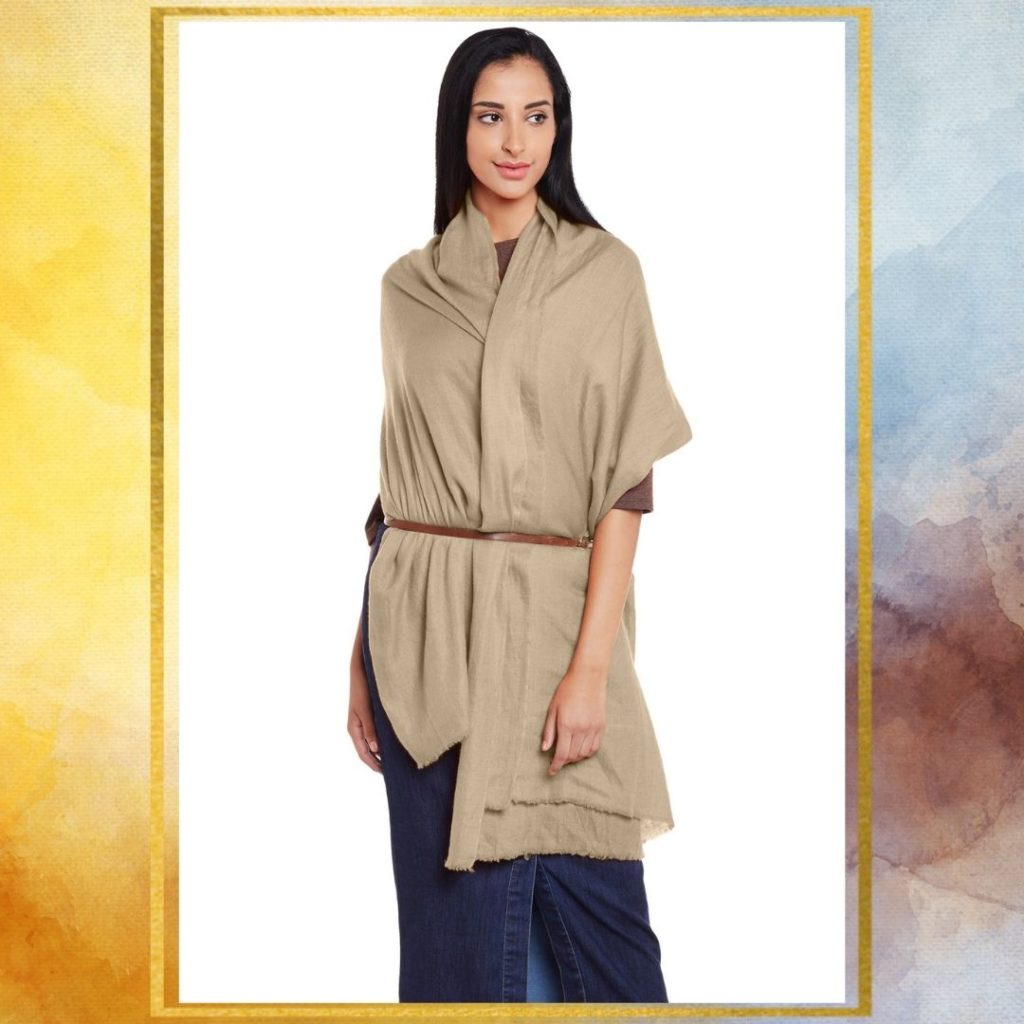
Even if the fabric is plain, a solid Pashmina still has varieties based on the pattern of the weave. Note that a Kashmiri Pashmina is handwoven over a traditional handloom in a number of patterns manually. This brings into existence a few varieties in solid types of Pashmina shawls.
Twill Weave Women's Pashmina
Twill is a type of weave that produces diagonal parallel ribs over the base of Pashmina. In the twill weave, artisans weave the weft across warp at a jog converse to a straight criss-cross fashion. This results in diagonal ridges all over the fabric. The ridges are quite visible when one sees this type of Pashmina closely.
When woven in a twill weave, the base is strong enough to hold embroidery motifs. As such these are the pieces that specialists choose for embroidery
Diamond Weave
Mostly artisans weave Pashmina shawls in the diamond weave. This is because this pattern gives the otherwise plain fabric more life and grace. When woven in a diamond weave, a Pashmina base will be full of tiny lozenge-shaped squares. This has earned it the name of ‘Chashme Bulbul’ meaning ‘Eye of a Bulbul’. Because this type of weave makes the piece a classic in itself, it is usually left plain. No further adornments and value additions.
Basket Weave
The weave is a basic loose, almost gauzy weave. In this weave, two or more wefts are laid out in a criss-cross fashion across two or more warps. Doing so gives the base a texture. Artisans weave the threads exactly like a basket and upon close monitoring, the criss-cross patterns are clearly visible.
More than the weave, there are certain factors that determine the quality of a Pashmina. It is important to note here that these parameters show the durability and strength of the Pashmina you wear.
The thickness of Cashmere fibres
For a fabric to qualify as Pashmina, the average diameter of the fibre has to be between 12-16 microns. In fact, the finer the fibre, the more high quality and exclusive the product is.
Yarn Count
A yarn count is a number that indicates how many meters of yarn can be spun pr. gram. Hence the higher the yarn count, the thinner and smoother a Pashmina will be. Therefore if we say a Pashmina of yarn-count 100, it means that 100 metres of spun yarn weigh 1 gram. Imagine how fine the thread would be!
Ply
Ply indicates the number of yarns spun together to one thread. One-ply indicates that one single yarn is used, while 2 ply would mean two strands of threads are used. The more yarns plied together, the stronger the Pashmina is.
Embellished Women's Pashminas
It was in the Mughal era when artisans embellished plain Pashminas with embroideries. But later, to meet the demands of modern customers, Pashminas got modish embellishments. This took it out of the stereotypical image of a “traditional accessory”. And currently, Pashminas brim with colours, laces, prints and patterns to make them appropriate in the modern fashion world
Ombre Pashmina
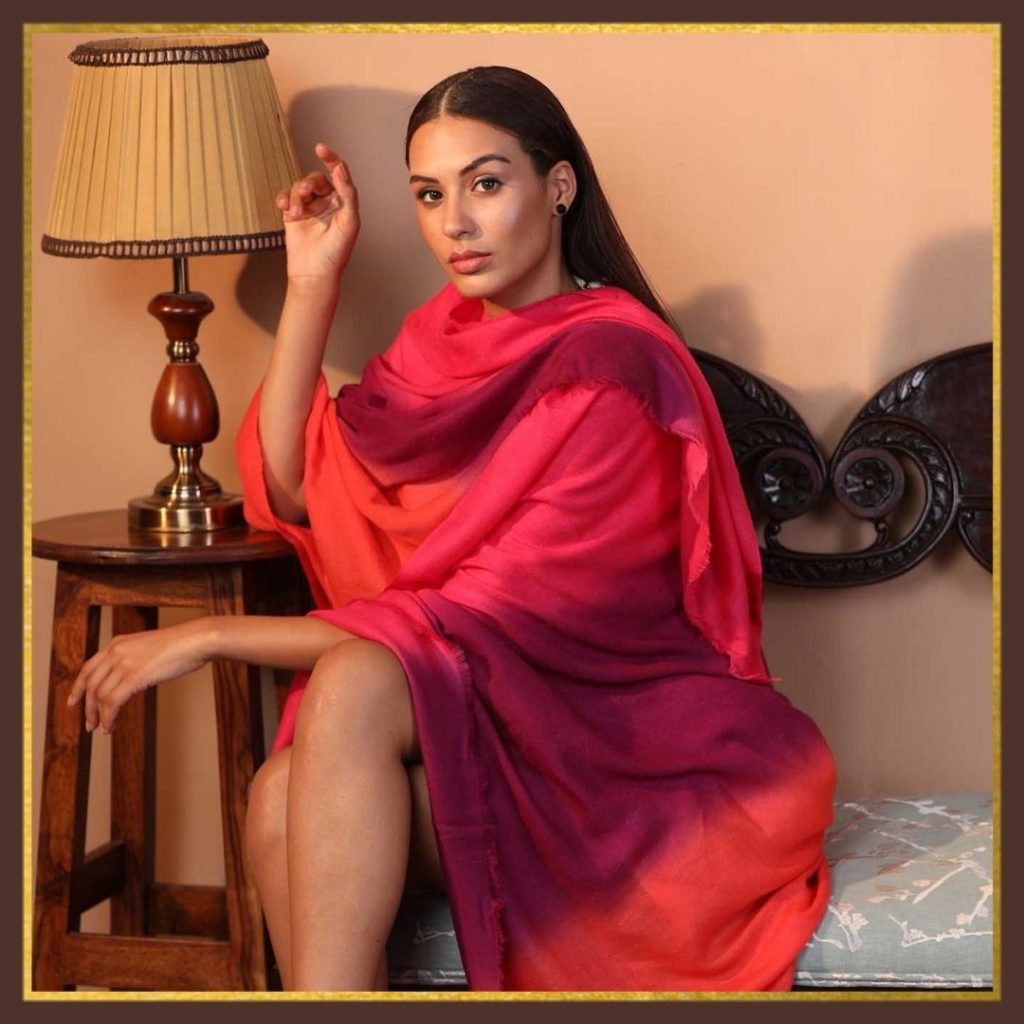
As the name suggests, an Ombre Pashmina is full of Ombre shades of brilliant colours. Hence, this makes it a modern fashion accessory. Artisans dip the wrap in colours and move it up and down in the dye container. This deepens some areas and keeps other areas subtler. A Pashmina can be dyed into more than two colours which highly depends on the skill of the dyer.
Printed Pashmina
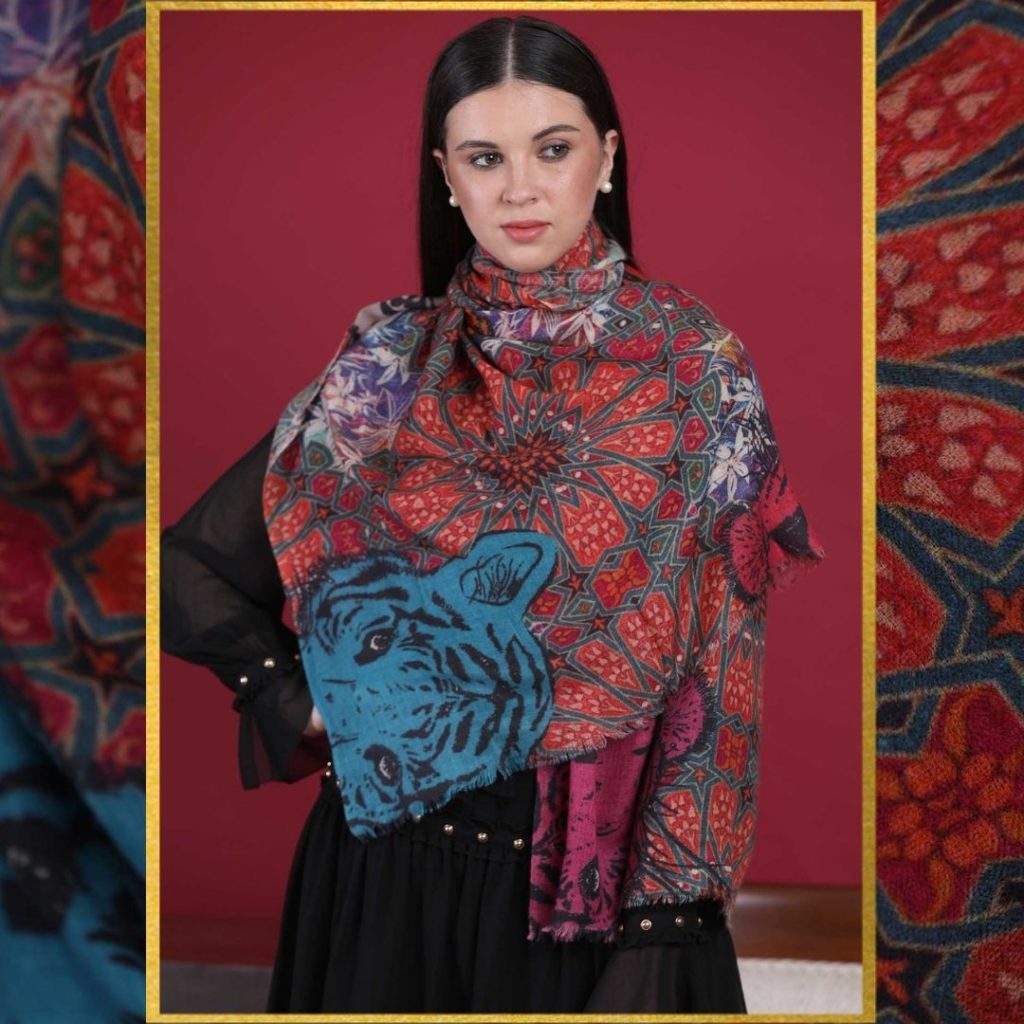
Pashminas have clearly seen a change to become chic accessories with modish prints. From animal prints to floral ones, Pashminas hold all prints with equal grace and elegance. Currently, there are leopard print Pashminas, animal print pashminas, floral print Pashminas, and even monogrammed Pashminas which make perfect customized gifts.
Patterned Pashmina
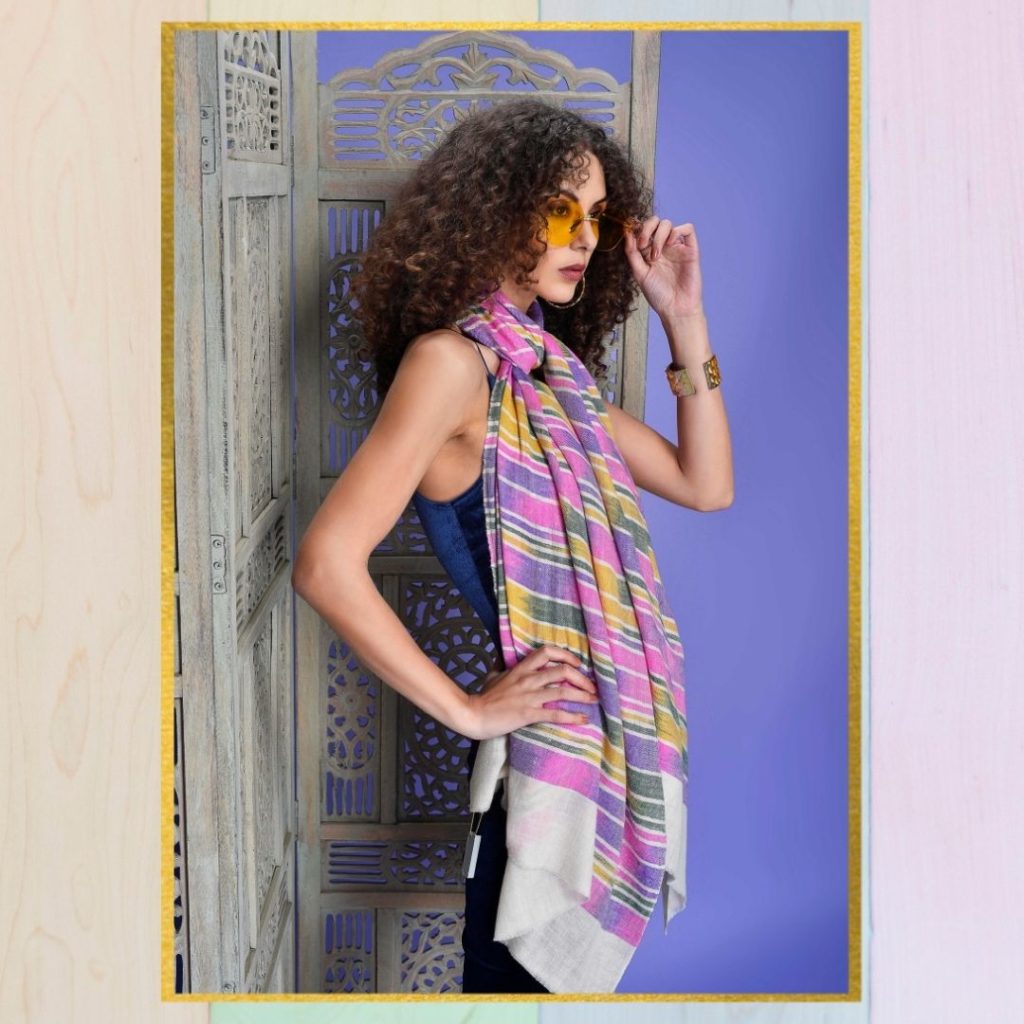
From pencil stripes to chic checks, from plaids to abstract patterns, a Pashmina shawl has adapted to as many patterns as the modern fashion world invents. Owing to these properties, Pashmina is the most versatile piece of fabric. Patterns in warm and brilliant colours bedeck an otherwise plain Pashmina in sheer charm and allure.
Lace Pashmina
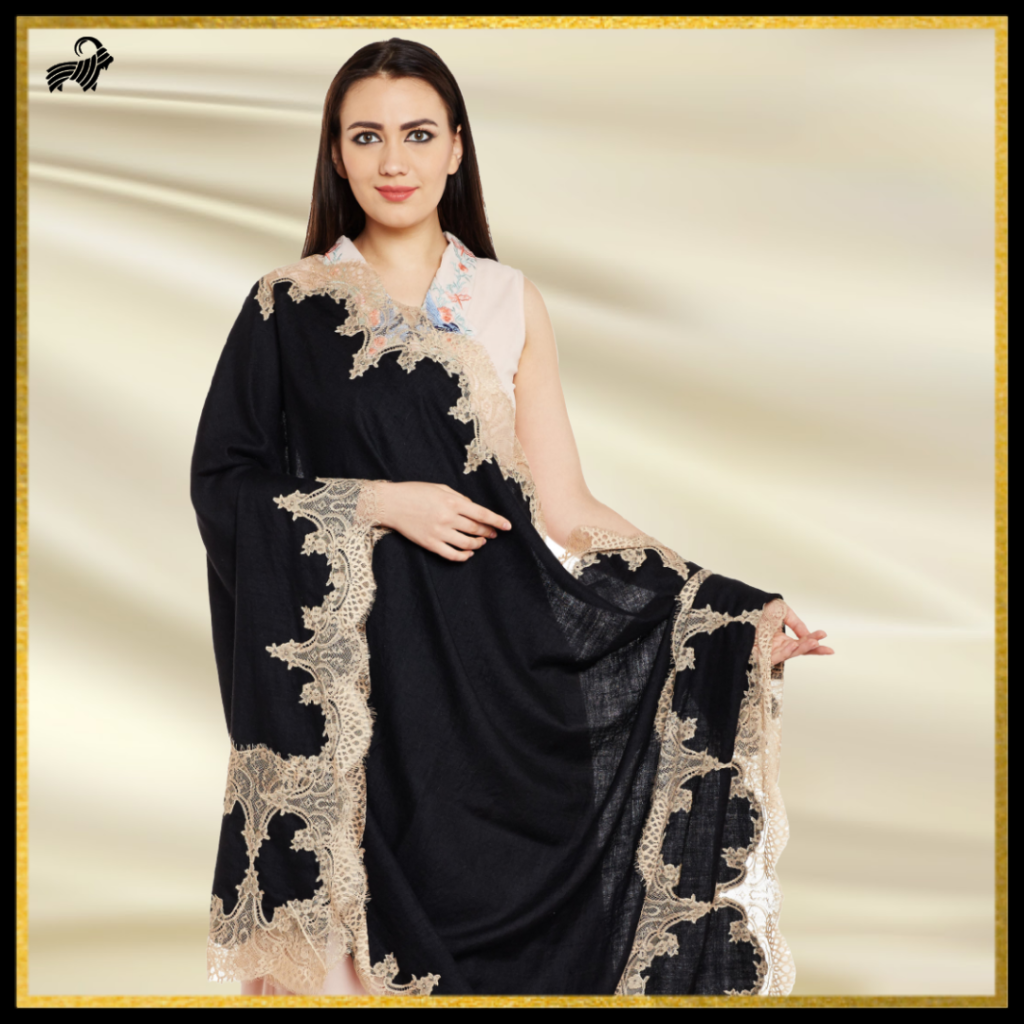
What could be more feminine than a fine netted lace wrapping around you in a pleasant fashion? The classic Pashmina shawl consists of a pretty French Chantilly lace. In detail, this dainty lace spans over the base for a more girly and feminine touch.
Swarovski Studded Pashmina
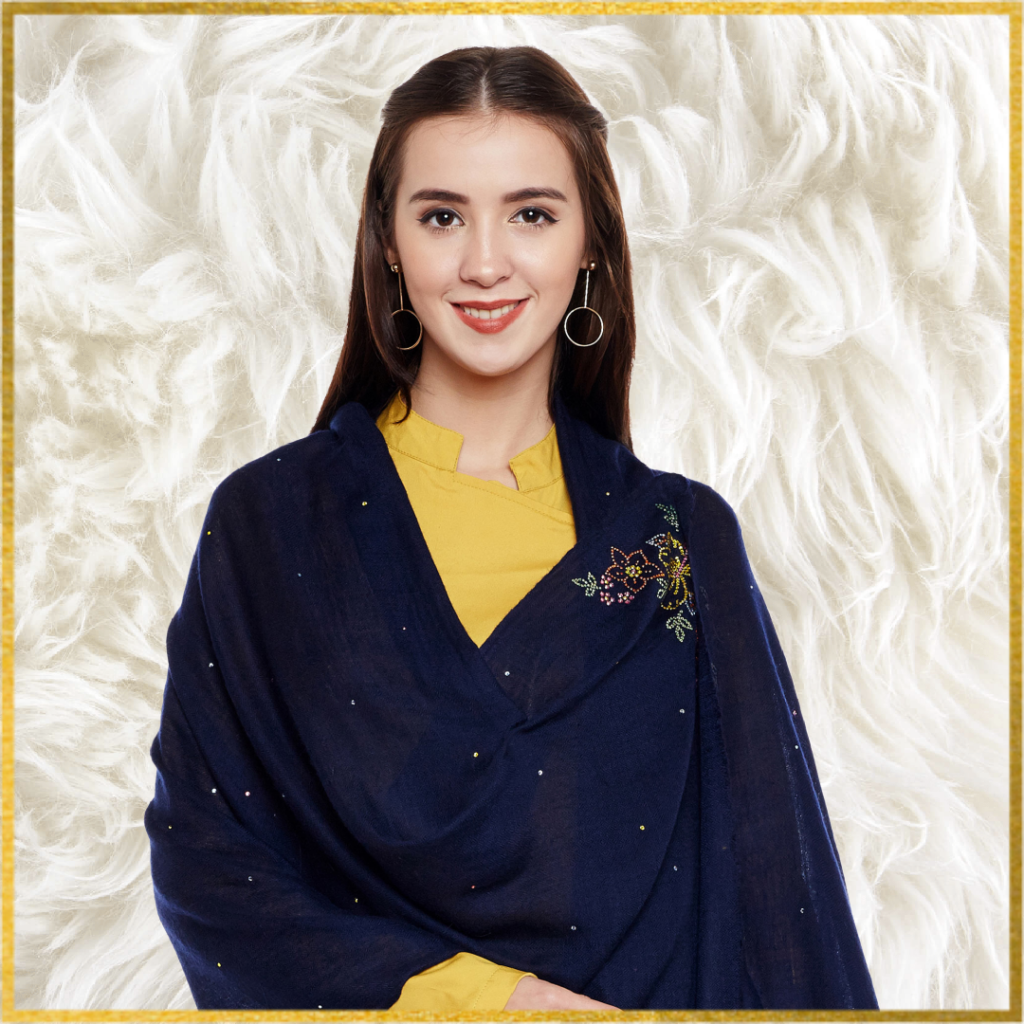
One more pattern which makes the rich Pashmina base beam with glittery studs is a Swarovski Pashmina. In this case, tiny golden or silver Swarovski studs are put over the base. This makes the shawl apt to wear on casual days & semi-formal events.
Embroidered Pashmina
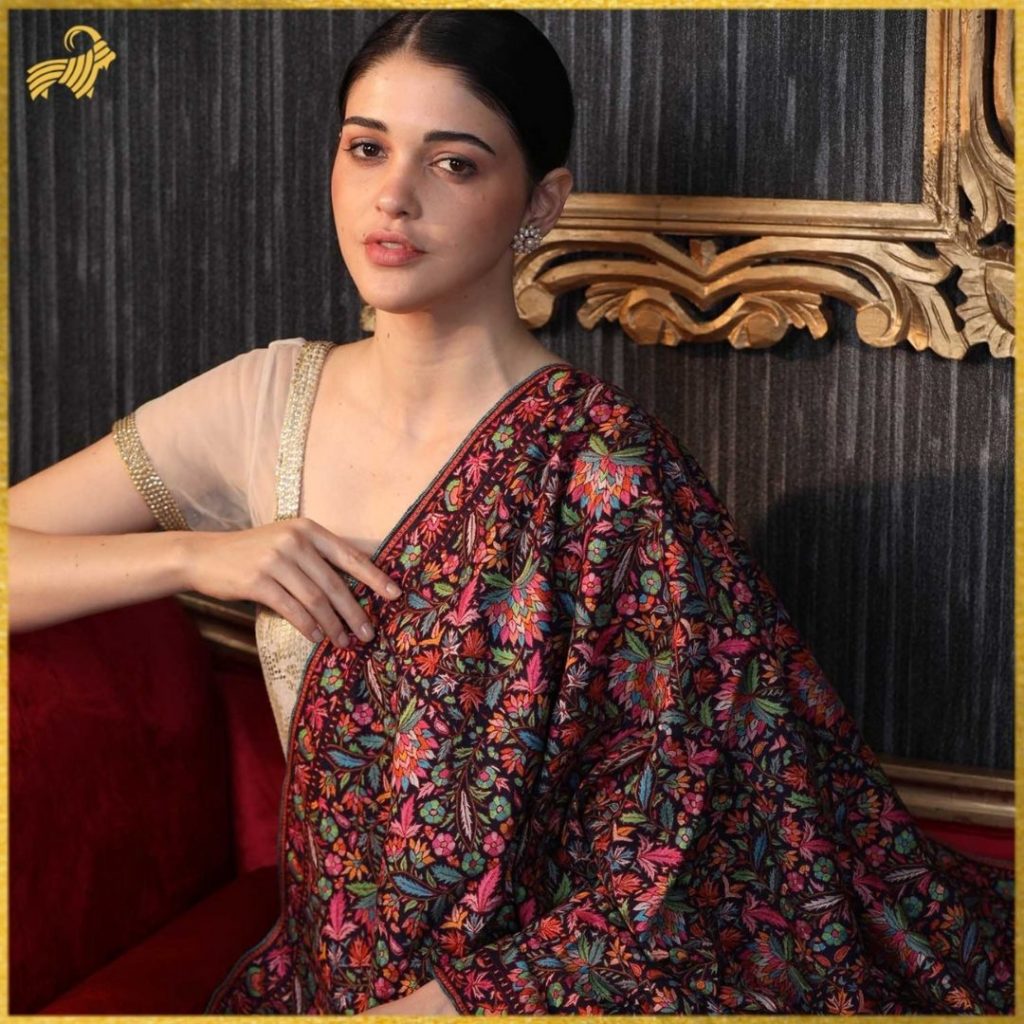
Perhaps the most loved and cherished type of Pashmina shawl would be one with classic embroidery motifs. Since an embroidered Pashmina shawl needs more details and in-depth analysis and attention, it would be discussed separately in the next section.
Also read: Kashmiri Artisans - Hands behind the Craft
Embroidered Women's Pashminas
The warmth of the meticulous hands of an artisan is always evident on an embroidered Pashmina. In this rendezvous, the magic does not end at the finest fabric base it has. It becomes more swoon-worthy when embroidered with the golden hands of expert artisans
Kashmiri Pashmina was first embroidered during the Mughal era. Even now the influence of Mughal culture can be widely seen over embroidery motifs. Designs like Shah Pasand (Emperor’s choice) and Buta Mohammed Shah (Muhammed Shah’s flower), both come from the Mughal era. Since then, embroiderers introduced many more motifs in this art and embroidered shawls became cherished all over the world.
Three main embroidery types done on Pashmina:
Sozni Embroidery
It is Sozni Kari that artisans mostly chosen to embroider a handwoven Pashmina shawl. This is because of its base being of a fragile texture and finesse. Since the underlying base is delicate as well, many consider Sozni Kari the best way to embroider a shawl
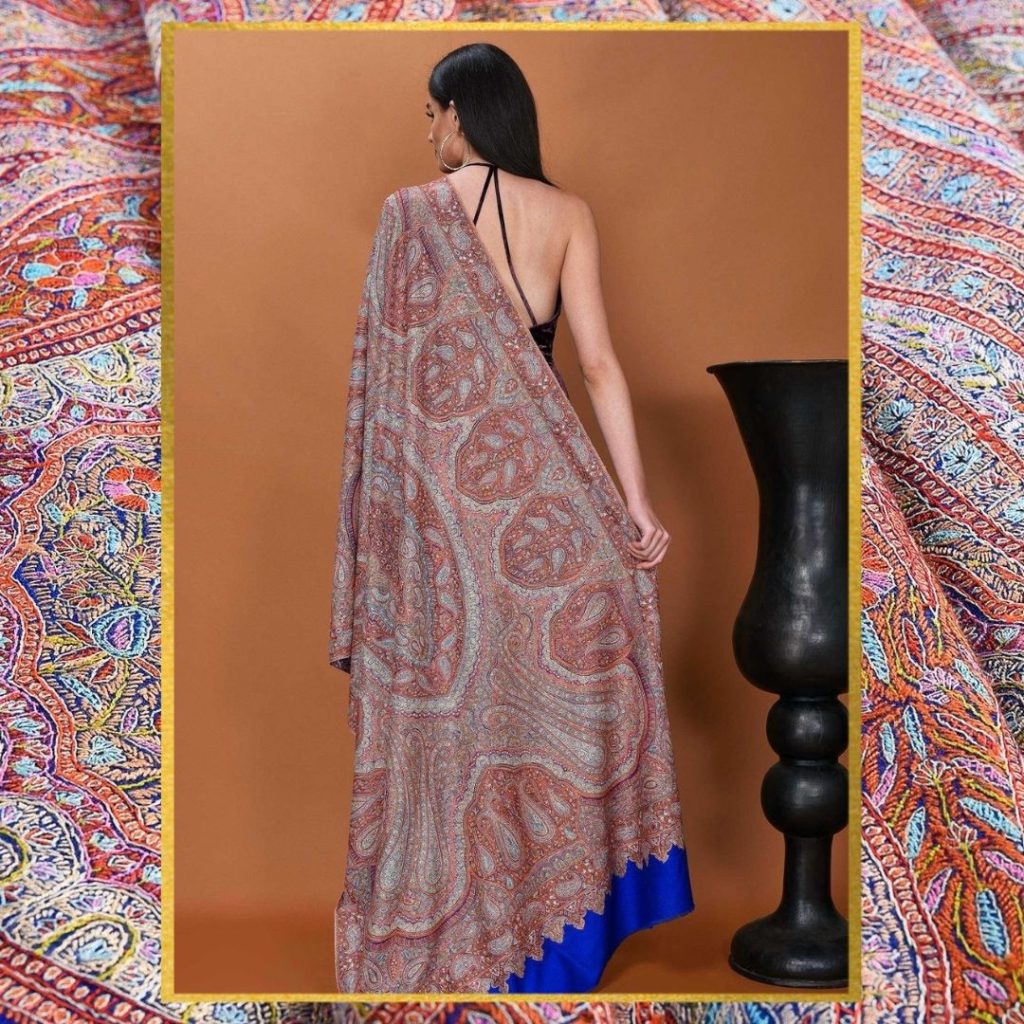
Locally known as sicznikeam (needle work), Sozni embroidery is one of the most refined forms of embroideries done in Kashmir. In fact, some believe that Sozni has no parallel whatsoever. This exceptionally fine, gossamer and artistic needle work needs the full attention and expertly skill of an artisan. In fact, it is these artisans who spend months and sometimes years together to complete one single piece.
Firstly, workers dip a finely carved walnut wood block in ink to stamp over the shawl for design. Next, they handover this imprinted shawl to an embroiderer. Lastly, the embroidery artisan used fine needles and threads to design the most beautiful patterns all over the base.
Papier Mache Embroidery
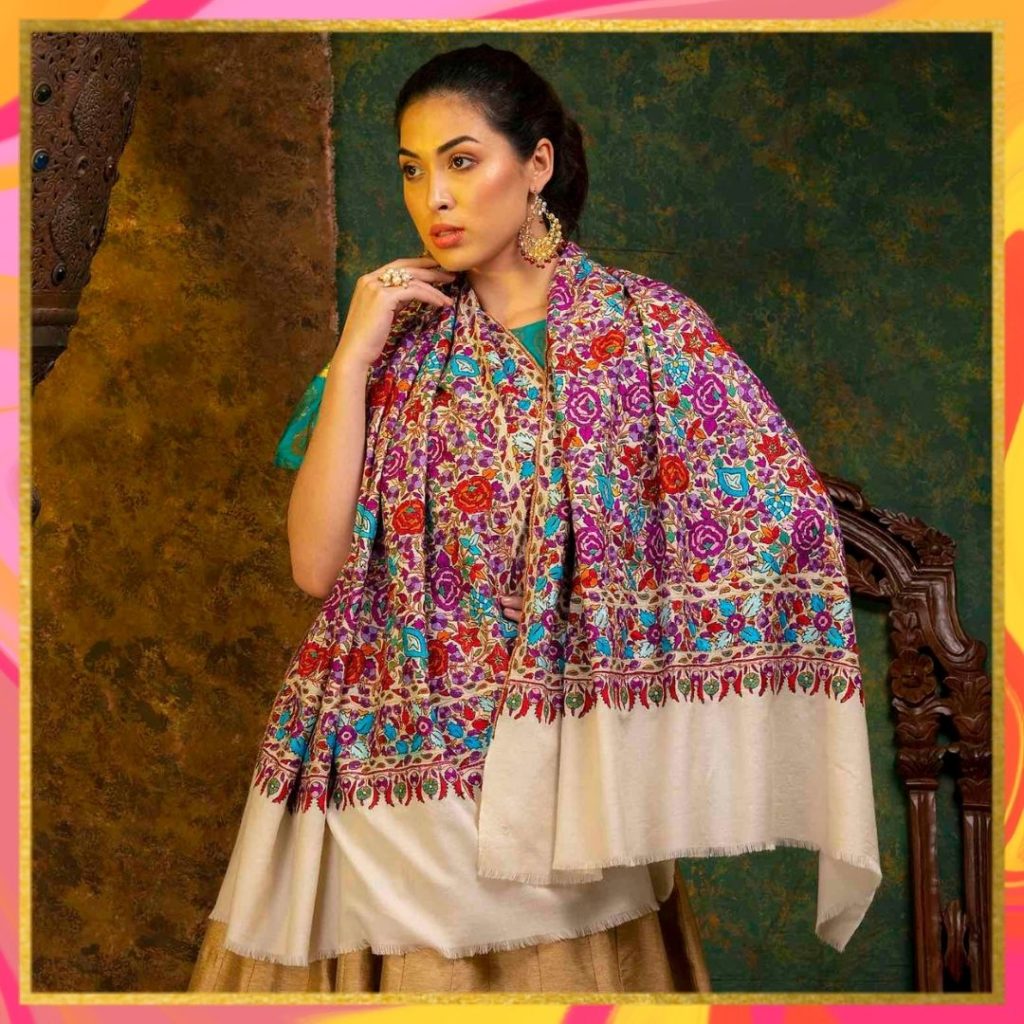
Yet another form of needlework is the Paper Mache embroidery which embellishes a Pashmina in bold and thick motifs in breathtaking colours. The name comes from the ancient art of Paper Mache (where specialists transform waste paper to beautiful hand painted articles), because of the similarity in the looks. The process of Paper Mache embroidery is the same as Sozni Kari, just that the thread used is thicker to make bolder strokes.
Tilla Dozi
This regal embroidery pattern was most used in Mughal royal courts and worn by nobles and the affluent ones. But back then, artisans used real gold and silver threads to embroider onto a Pashmina. But as royal courts started dissolving and common people started showing interest in Tilla Pashmina shawls, some metals were used instead of real gold/silver however with a coating of the same.
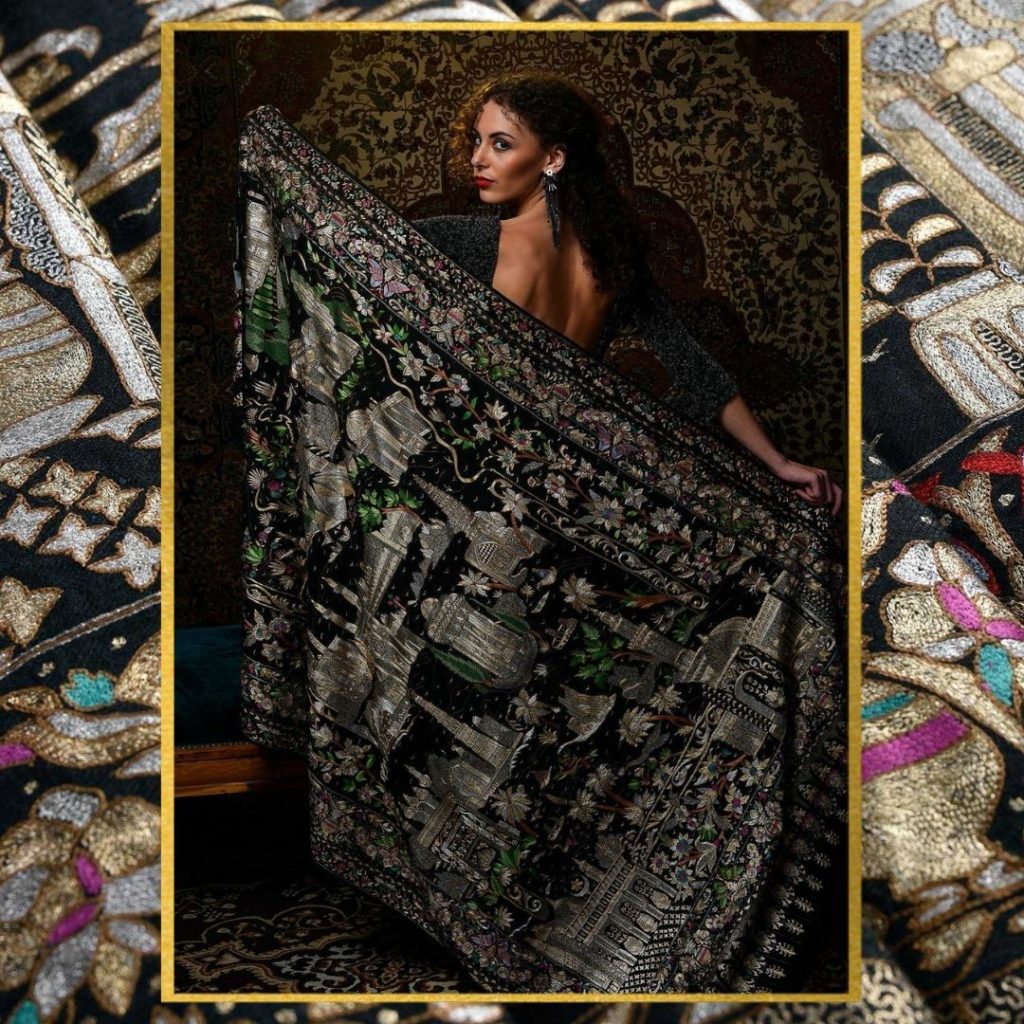
To begin with, a designer draws a design on a paper and performs the same. Next, artisans place this trace paper on a shawl and dust it with natural ink which traces the design over the shawl. Lastly, a Tilla embroidery specialist embroiders the shawl over the same design with malleable copper wires dipped in real gold or silver
Embroidery Patterns
There are a number of unique ways in which artisans lay embroidery motifs on a Pashmina shawl. The worth of a shawl is decided upon the quantity of embroidery threads used over the shawl.
Dordaar/Baildaar
In this case, embroidery runs all over the four sides of a shawl bordering all sides in beautiful motifs. The embroidery is of varied widths like 2 inch, 3 inch and the like
Hashidaar
Mostly done in Sozni, a Hashidaar shawl contains an embroidered border all around, with the addition of a stylized paisley flower over the four corners
Bootidaar
This type of embroidery pattern sprinkles the entire base with small motifs of flowers or paisleys or butterflies and more at regular intervals.
Palladaar
Artisans border this shawl over the width with broad embroidery border but over the length a comparatively narrow border
Jaalidaar
In this pattern, artisans intricately embroider the shawl over its base with webbed embroidery motifs which cover the entire shawl. They mostly choose intertwined flowers as motifs, and lay them all over the base in a loose pattern
Jamawar
The richest embroidery pattern in which motifs cover the shawl in such a dense fashion that the base is barely visible. Artisans embroider such shawls in Sozni or Paper Mache due to the delicacy of the base. These shawls take 3-5 years to complete.
Kani Weave Women's Pashmina
It was in the 18th century when French monarch Napoleon on his return from a campaign to Egypt bought his wife Josephine a Kani shawl. The Empress liked so much that she later ordered hundreds of the same. A Kani Pashmina shawl is mostly seen in a Kashmiri bride’s wedding trousseau. Women also wear it to exceptionally special events, where they definitely want to be in the spotlight and look the best of any version of themselves.

Kani literally means small bobbins. It is these small wooden bobbins or sticks that are wound with colourful threads. These thread laden sticks are inserted during the weaving process of a Kani shawl, thereby embedding the base with beautiful colours and patterns. Note that for a three feet wide length, around 400 kani sticks are to be used and depending upon the design and complexity of a Kani shawl. It takes the artisan 1 day to complete just one inch, and 3 to 36 months to complete the entire piece.
Reversible Women's Pashmina
If there is magic in weaving, it is evident here in this type of Pashmina shawl. A reversible or Do Rukha (meaning two faced) shawl is woven in such a fashion that the front side is different in colour or shade from the back side. Its an expert weaver who does the magic. He uses two different coloured threads over a loom and weaves the threads in such a way to cover the two different sides in different patterns. Experts carefully choose the colour combinations, taking into account the compatibility, trending colours and choices of common people.
Variations
Because the reversible shawl is a masterpiece in itself, artisans introduced many variations in it.
A. The simpler one is when threads of two different colours are woven together. Its a pattern in which the top layer uses one colour and the bottom layer a different one. What comes into existence is a shawl of two shades and each one is more alluring than the other. It is up to the design of the shawl if it uses two different shades of the same colour or two completely different colours for the two sides.
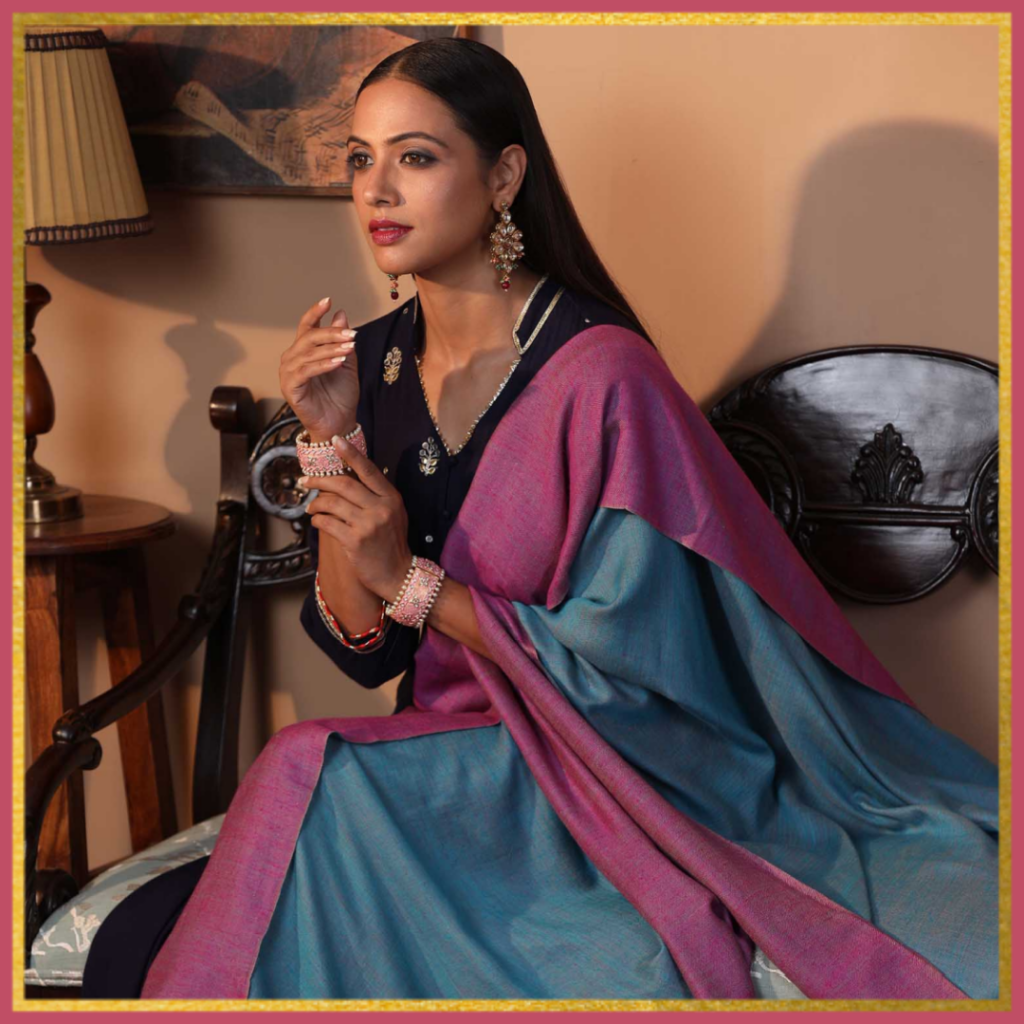
B. Another one was adding Tilla or Zari threads during the weave such that the front side of the shawl would be shimmery and the backside more pastel.
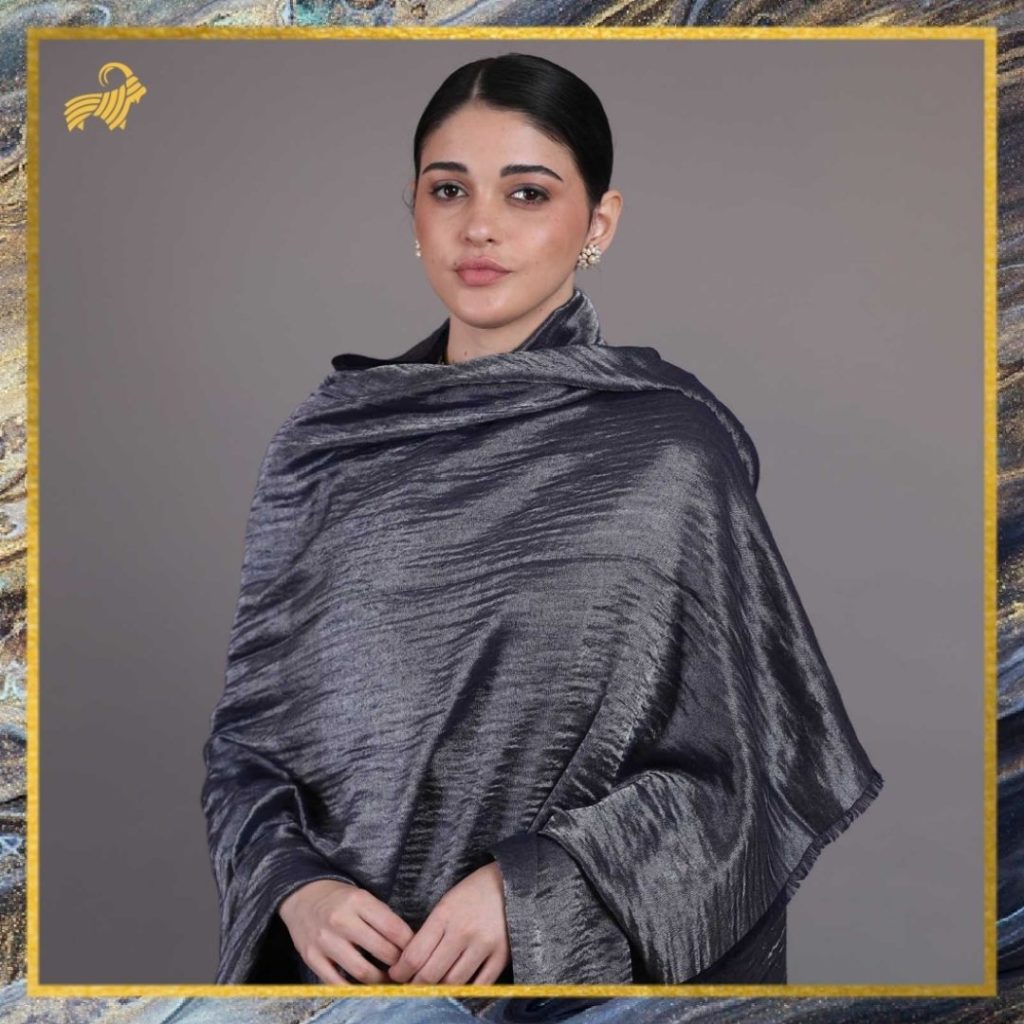
C. Then there was this ethereal version of the Reversible shawl which made this magical piece more beguiling, breathtaking, and worth each love-filled look that falls on it - the embroidered reversible shawl or an Aksi Do Rukha (Aks means mirror image or reflection).
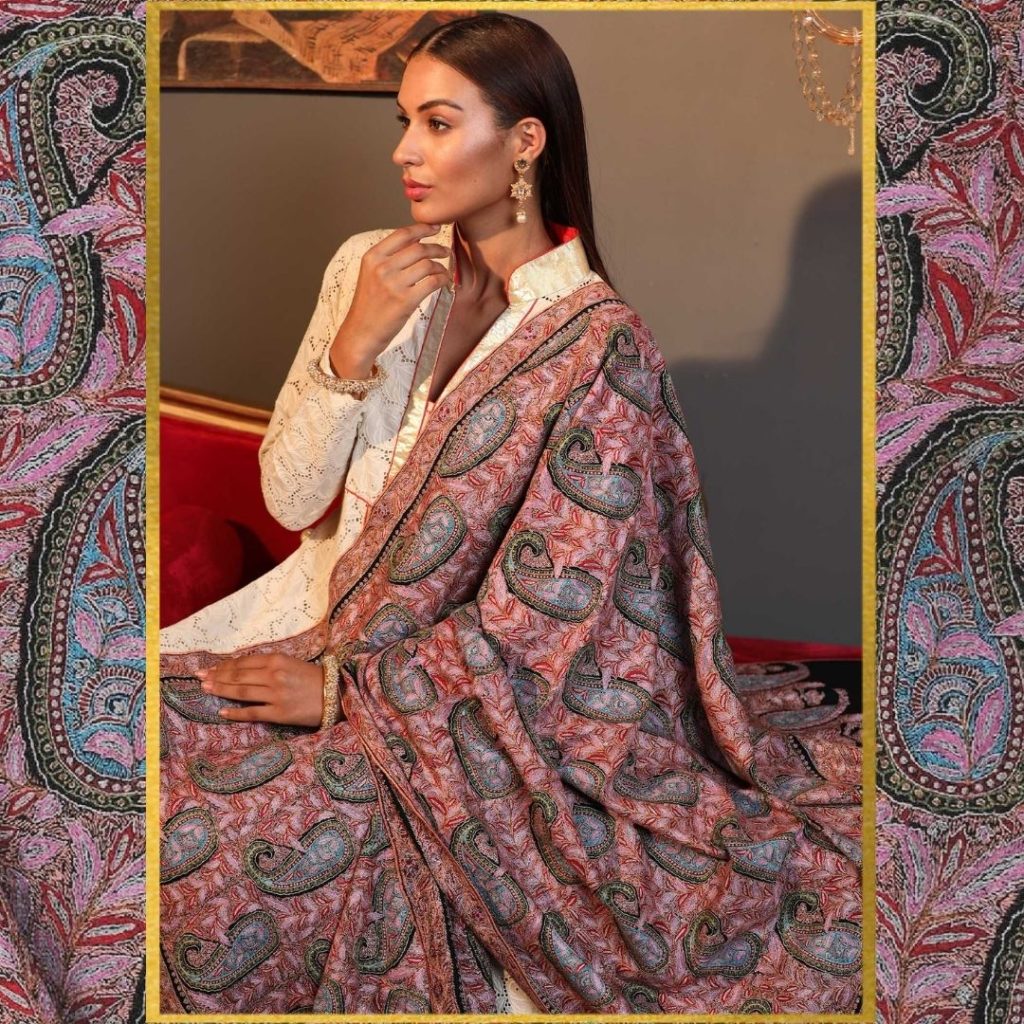
An Aksi Do Rukha Pashmina shawl features bold and colourful embroidery motifs from the front side and a mirror image of the same from the back. One feels like having two fully hand embroidered shawls in one. With such magnificent looks and painstaking efforts of the artisan, this shawl is more extravagant and pricey than the others and has earned a global acclaim for its superior craftsmanship and artful look.
Kalamkari Women's Pashminas
Kalamkari Pashmina shawls are nothing short of a painting when it comes to the mere looks of it. The word Kalamkari is made up of two words, 'Kalam' meaning 'Pen' and 'Kari' meaning 'work'. Hence Kalamkari is actually an artwork that uses bold brushes to paint magical motifs over Pashmina shawls. A unique characteristic of this shawl that distinguishes it from cheap copies is the careful mix of colours and the intricate hand-drawn motifs.
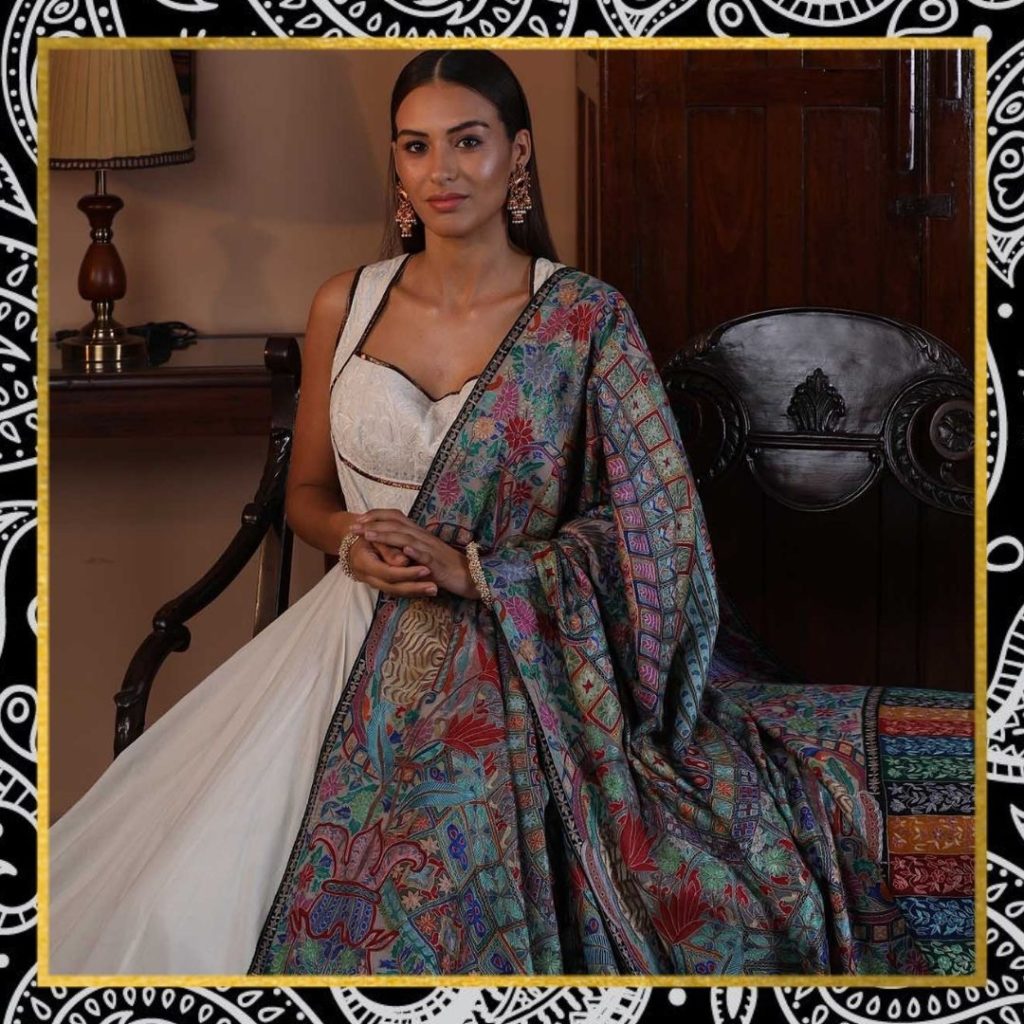
After a designer gives the design to be imprinted over a Pashmina, a specialist Kalamkaar uses a bamboo pen with a flat nib. He dips this nib into a special ink, and makes with his hands some exceptionally beguiling designs, making the shawl nothing less than an art piece. In Kashmir, some artisans further embroider these shawls over the painted motifs for a more prominent effect.
What is Water Pashmina?
A relatively new kind of women's Pashmina has started surfacing online websites and stores everywhere by the name of Water Pashmina, upon thorough research (both primary and secondary) on the same, we came to know that water Pashmina is simply a synthetic blend of fibre and has a minimum thread count of Pashmina (at the most 70%). Dealers of this Pashmina claim that one can wear these all year round. This makes it obvious that this variety has nothing to do with Pashmina. These Pashminas are full of shine and are reversible, but definitely not worth keeping in this list of pure and original Kashmiri Pashminas
To date, artisans have embellished women's Pashmina shawls in just these 5 or 6 patterns. It won't be completely erroneous to say that as fashionistas fall in love with Pashmina, more and more patterns will be acquainted with Pashmina. As patrons, we have to wait patiently and look forward to what the future world of Pashmina has in store for us.